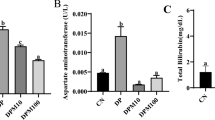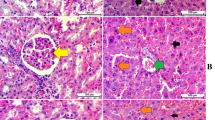Abstract
The present study brings out the preventive role of (−)-epigallocatechin-gallate (EGCG) on cardiac mitochondrial metabolism and apoptosis in cigarette smoke (CS)-exposed rats. The CS-exposed rats showed significantly decreased activities of TCA cycle enzymes and mitochondrial enzymatic antioxidants, on the other hand, mitochondrial lipid peroxidation was increased and GSH level was decreased. Further, CS exposure was found to induce cardiac apoptosis through release of cytochrome c into the cytosol, cleavage of pro-caspase-3 to active caspase-3, up-regulation of pro-apoptotic (Bax) and down-regulation of antiapoptotic (Bcl-2) molecules. The CS-induced apoptosis was further confirmed by mitochondrial and nuclear ultra structural apoptotic features as evaluated by electron microscopic studies. EGCG supplementation shelters the activities of TCA cycle enzymes and antioxidant enzymes, with concomitant decrease in lipid peroxidation and increase in GSH level. EGCG administration inhibited apoptosis through the inhibition of cytochrome c release into cytosol, activation of pro-caspase-3, down regulation of Bax and significant up regulation of Bcl-2. EGCG reversed the ultra structural apoptotic alterations of mitochondria and nucleus. The present study has provided experimental evidences that the EGCG treatment enduring to cardio protection at mitochondrial level.








Similar content being viewed by others
Abbreviations
- CVD:
-
Cardiovascular disease
- CS:
-
Cigarette smoke
- EGCG:
-
(−)-Epigallocatechin-gallate
- ROS:
-
Reactive oxygen species
References
Goette A, Lendeckel U, Kuchenbecker A, Bukowska A, Peters B, Klein HU, Huth C, Rocken C (2007) Cigarette smoking induces atrial fibrosis in humans via nicotine. Heart 93(9):1056–1063
Zhou X, Sheng Y, Yang R, Kong X (2010) Nicotine promotes cardiomyocyte apoptosis via oxidative stress and altered apoptosis-related gene expression. Cardiology 115(4):243–250
Barnoya J, Glantz SA (2005) Cardiovascular effects of second hand smoke: nearly as large as smoking. Circulation 111(20):2684–2698
Kuo WW, Wu CH, Lee SD, Lin JA, Chu CY, Hwang JM, Ueng KC, Chang MH, Yeh YL, Wang CJ, Liu JY, Huang CY (2005) Second-hand smoke-induced cardiac fibrosis is related to the Fas death receptor apoptotic pathway without mitochondria-dependent pathway involvement in rats. Environ Health Perspect 113(10):1349–1353
Gokulakrishnan A, Jayachandran DB, Thirunavukkarasu C (2011) Attenuation of the cardiac inflammatory changes and lipid anomalies by (−)-epigallocatechin-gallate in cigarette smoke exposed rats. Mol Cell Biochem 354(1–2):1–10
Yamada S, Zhang XQ, Kadono T, Matsuoka N, Rollins D, Badger T, Rodesch CK, Barry WH (2009) Direct toxic effects of aqueous extract of cigarette smoke on cardiac myocytes at clinically relevant concentrations. Toxicol Appl Pharmacol 236(1):71–77
Gvozdjakova A, Kucharska J, Gvozdjak J (1992) Effect of smoking on the oxidative processes of cardiomyocytes. Cardiology 81(2–3):81–84
Van Jaarsveld H, Kuyl J, Alberts DW (1992) Antioxidant vitamin supplementation of smoke exposed rats partially protects against myocardial ischemic reperfusion injury. Free Radic Res Commun 17(4):263–269
Aoshiba K, Tamaoki J, Nagai A (2001) Acute cigarette smoke exposure induces apoptosis of alveolar macrophages. Am J Physiol Lung Cell Mol Physiol 281(6):L1392–L1401
Miro O, Alonso JR, Jarreta D, Casademont J, Urbano-Márquez A, Cardellach F (1999) Smoking disturbs mitochondrial respiratory chain function and enhances lipid peroxidation on human circulating lymphocytes. Carcinogenesis 20(7):1331–1336
Kim NH, Kang PM (2010) Apoptosis in cardiovascular diseases: mechanism and clinical implications. Korean Circ J 40(7):299–305
Clerk A, Cole SM, Cullingford TE, Harrison JG, Jormakka M, Valks DM (2003) Regulation of cardiac myocyte cell death. Pharmacol Ther 97(3):223–261
Zhou X, Li C, Xu W, Chen J (2012) Trimetazidine protects against smoking-induced left ventricular remodeling via attenuating oxidative stress, apoptosis, and inflammation. PLoS ONE 7(7):e40424
Das A, Dey N, Ghosh A, Das S, Chattopadhyay DJ, Chatterjee IB (2012) Molecular and cellular mechanisms of cigarette smoke-induced myocardial injury: prevention by vitamin C. PLoS ONE 7(9):e44151
Ramesh T, Sureka C, Bhuvana S, Hazeena Begum V (2010) Sesbania grandiflora diminishes oxidative stress and ameliorates antioxidant capacity in liver and kidney of rats exposed to cigarette smoke. J Physiol Pharmacol 61(4):467–476
Banerjee S, Chattopadhyay R, Ghosh A, Koley H, Panda K, Roy S, Chattopadhyay D, Chatterjee IB (2008) Cellular and molecular mechanisms of cigarette smoke-induced lung damage and prevention by vitamin C. J Inflamm 5:21
Hirai M, Hotta Y, Ishikawa N, Wakida Y, Fukuzawa Y, Isobe F, Nakano A, Chiba T, Kawamura N (2007) Protective effects of EGCG or GCG, a green tea catechin epimer, against post ischemic myocardial dysfunction in guinea-pig hearts. Life Sci 80(11):1020–1032
Velayutham P, Babu A, Liu D (2008) Green tea catechins and cardiovascular health. Curr Med Chem 15(18):1840–1850
Sheng R, Gu ZL, Xie ML, Zhou WX, Guo CY (2007) EGCG inhibits cardiomyocyte apoptosis in pressure overload induced cardiac hypertrophy rats and protects cardiomyocyte from oxidative stress. Acta Pharmacol Sin 28(2):191–201
Anbarasi K, Vani G, Shyamala Devi CS (2005) Protective effect of bacoside A on cigarette smoking-induced brain mitochondrial dysfunction in rats. J Environ Pathol Toxicol Oncol 24(3):225–234
Jhonson D, Lardy H (1967) Isolation of liver and kidney mitochondria. In: Estabrook RW (ed) Methods in enzymology, vol 10. Academic Press, London, pp 94–96
Ohkawa H, Ohishi N, Yagi K (1979) Assay for lipid peroxides in animal tissue by thiobarbituric acid reaction. Anal Biochem 95(2):351–358
Ellman GL (1959) Tissue sulphydryl groups. Arch Biochem Biophys 82(1):70–77
Misra HP, Fridovich I (1972) The role of superoxide anion in the auto oxidation of epinephrine and a simple assay of superoxide dismutase. J Biol Chem 247(10):3170–3175
Sinha AK (1972) Colorimetric assay of catalase. Anal Biochem 47(2):389–394
Rotruck JT, Pope AL, Ganther HE, Hafeman DG, Hoekstra G (1973) Selenium biochemical role as a component of glutathione peroxidase. Science 179(4073):588–590
Habig WH, Jakoby WB (1981) Assays for differentiation of glutathione-s-transferases. Methods Enzymol 77:398–405
Carlberg I, Mannervik B (1975) Purification and characterization of the flavo enzyme glutathione reductase from rat liver. J Biol Chem 250(14):5475–5480
King J (1965) Isocitrate dehydrogenase. In: King JC, Van D (eds) Practical clinical enzymology. Nostrand Co., London, p 363
Reed LJ, Mukherjee RB (1969) α-Ketoglutarate dehydrogenase complex from Escherichia coli. In: Lewinstein JM (ed) Methods in enzymology. Academic Press, New York, pp 55–61
Slater EC, Borner WD Jr (1952) The effect of fluoride on the succinic oxidase system. Biochem J 52(2):185–196
Mehler AH, Kornberg A, Criscuoli S, Ochoa S (1948) The enzymatic mechanism of oxidation reductions between malate or isocitrate or pyruvate. J Biol Chem 174(3):961–977
Minakami S, Ringler RL, Singer TP (1962) Studies on the respiratory chain-linked dihydro diphospho pyridine nucleotide dehydrogenase. I. Assay of the enzyme in particulate and in soluble preparations. J Biol Chem 237:569–576
Pearl W, Caocarano J, Zweifach BW (1963) Microdetermination of cytochrome oxidase in rat tissues by the oxidation on N-phenyl-phenylenediamine or ascorbic acid. J Histochem Cytochem 11(1):102–107
Lowry OH, Rosebrough NJ, Farr AL, Randall RJ (1951) Protein measurement with the Folin phenol reagent. J Biol Chem 193(1):265–275
Sambrook J, Fritsch EF, Maniatis T (1989) Molecular cloning—a laboratory manual, 2nd edn. Cold Spring Harbor Laboratory Press, Cold Spring Harbor, p 1.74
Crow MT, Mani K, Nam YJ, Kitsis RN (2004) The mitochondrial death pathway and cardiac myocyte apoptosis. Circ Res 95(10):957–970
Chen H, Vlahos R, Bozinovski S, Jones J, Anderson GP, Morris MJ (2005) Effect of short-term cigarette smoke exposure on body weight, appetite and brain neuropeptide Y in mice. Neuropsychopharmacology 30(4):713–719
Ramesh T, Begum VH (2008) Protective effect of Sesbania grandiflora against cigarette smoke-induced oxidative damage in rats. J Med Food 11(2):369–375
Devika PT, Stanley Mainzen Prince P (2008) (−)Epigallocatechin-gallate (EGCG) prevents mitochondrial damage in isoproterenol-induced cardiac toxicity in albino Wistar rats: a transmission electron microscopic and in vitro study. Pharmacol Res 57(5):351–357
Fu Y, Zheng S, Lu SC, Chen A (2008) Epigallocatechin-3-gallate inhibits growth of activated hepatic stellate cells by enhancing the capacity of glutathione synthesis. Mol Pharmacol 73(5):1465–1473
Sheng R, Gu ZL, Xie ML, Zhou WX, Guo CY (2009) EGCG inhibits proliferation of cardiac fibroblasts in rats with cardiac hypertrophy. Planta Med 75(2):113–120
Sheng R, Gu ZL, Xie ML, Zhou WX, Guo CY (2010) Epigallocatechin gallate protects H9c2 cardiomyoblasts against hydrogen dioxides-induced apoptosis and telomere attrition. Eur J Pharmacol 641(2–3):199–206
Sun L, Luo C, Long J, Wei D, Liu J (2006) Acrolein is a mitochondrial toxin: effects on respiratory function and enzyme activities in isolated rat liver mitochondria. Mitochondrion 6(3):136–142
Fickl H, Van Antwerpen VL, Richards GA, Van der Westhuyzen DR, Davies N, Van der Walt R, Van der Merwe CA, Anderson R (1996) Increased levels of autoantibodies to cardiolipin and oxidised low density lipoprotein are inversely associated with plasma vitamin C status in cigarette smokers. Atherosclerosis 124(1):75–81
Hu N, Guo R, Han X, Zhu B, Ren J (2011) Cardiac-specific over expression of metallothionein rescues nicotine-induced cardiac contractile dysfunction and interstitial fibrosis. Toxicol Lett 202(1):8–14
Adams JM (2003) Ways of dying: multiple pathways to apoptosis. Genes Dev 17(20):2481–2495
Zornoff LA, Matsubara LS, Matsubara BB, Okoshi MP, Okoshi K, Dal Pai-Silva M, Carvalho RF, Cicogna AC, Padovani CR, Novelli EL, Novo R, Campana AO, Paiva SA (2006) Beta-carotene supplementation attenuates cardiac remodeling induced by one-month tobacco-smoke exposure in rats. Toxicol Sci 90(1):259–266
Acknowledgments
We gratefully acknowledge the assistance from Dr. P. V. Anandhbabu, Dr. Murali, Dr. P. Ashok Kumar, and Dr. S. Bharathiraja. We also acknowledge Prof. B. Kannabiran (Retired), Department of Biochemistry and Molecular Biology, Pondicherry University, Puducherry, India for his assistance while revising this manuscript.
Author information
Authors and Affiliations
Corresponding author
Rights and permissions
About this article
Cite this article
Adikesavan, G., Vinayagam, M.M., Abdulrahman, L.A. et al. (−)-Epigallocatechin-gallate (EGCG) stabilize the mitochondrial enzymes and inhibits the apoptosis in cigarette smoke-induced myocardial dysfunction in rats. Mol Biol Rep 40, 6533–6545 (2013). https://doi.org/10.1007/s11033-013-2673-5
Received:
Accepted:
Published:
Issue Date:
DOI: https://doi.org/10.1007/s11033-013-2673-5




